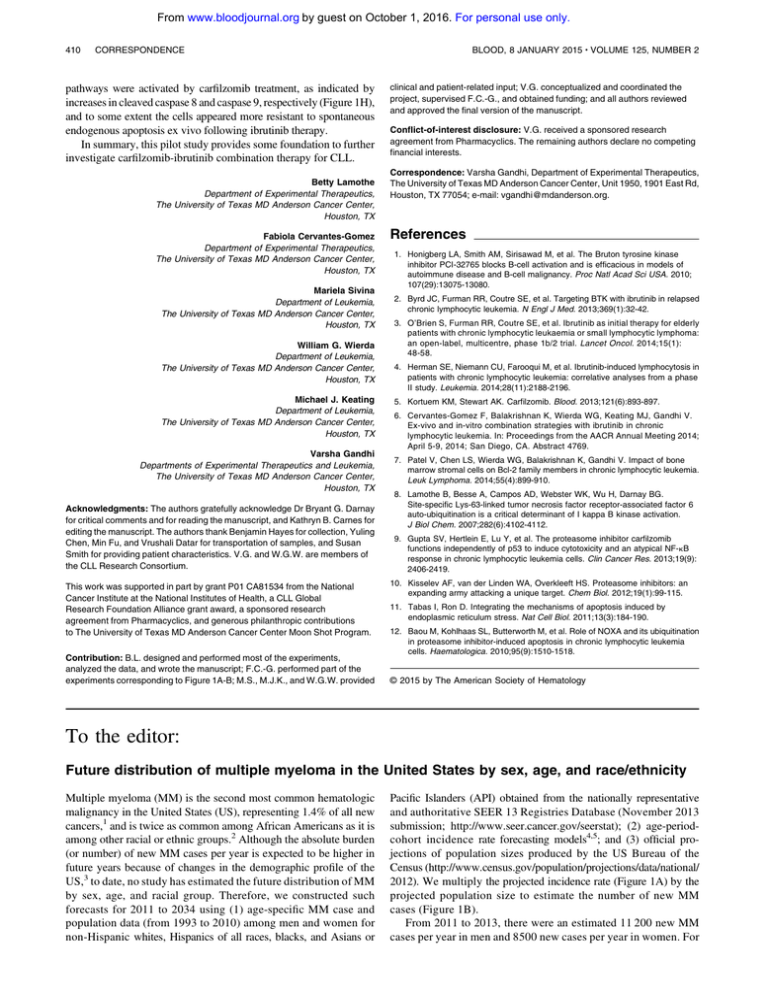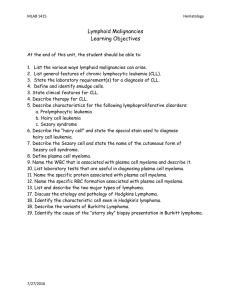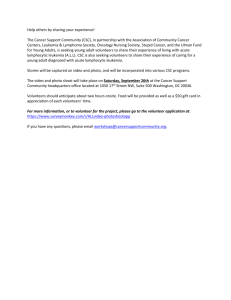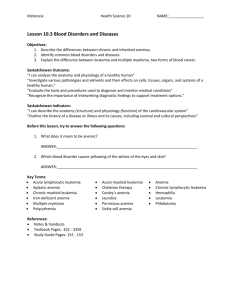
From www.bloodjournal.org by guest on October 1, 2016. For personal use only.
410
BLOOD, 8 JANUARY 2015 x VOLUME 125, NUMBER 2
CORRESPONDENCE
pathways were activated by carfilzomib treatment, as indicated by
increases in cleaved caspase 8 and caspase 9, respectively (Figure 1H),
and to some extent the cells appeared more resistant to spontaneous
endogenous apoptosis ex vivo following ibrutinib therapy.
In summary, this pilot study provides some foundation to further
investigate carfilzomib-ibrutinib combination therapy for CLL.
Betty Lamothe
Department of Experimental Therapeutics,
The University of Texas MD Anderson Cancer Center,
Houston, TX
Fabiola Cervantes-Gomez
Department of Experimental Therapeutics,
The University of Texas MD Anderson Cancer Center,
Houston, TX
Mariela Sivina
Department of Leukemia,
The University of Texas MD Anderson Cancer Center,
Houston, TX
William G. Wierda
Department of Leukemia,
The University of Texas MD Anderson Cancer Center,
Houston, TX
Michael J. Keating
Department of Leukemia,
The University of Texas MD Anderson Cancer Center,
Houston, TX
Varsha Gandhi
Departments of Experimental Therapeutics and Leukemia,
The University of Texas MD Anderson Cancer Center,
Houston, TX
Acknowledgments: The authors gratefully acknowledge Dr Bryant G. Darnay
for critical comments and for reading the manuscript, and Kathryn B. Carnes for
editing the manuscript. The authors thank Benjamin Hayes for collection, Yuling
Chen, Min Fu, and Vrushali Datar for transportation of samples, and Susan
Smith for providing patient characteristics. V.G. and W.G.W. are members of
the CLL Research Consortium.
This work was supported in part by grant P01 CA81534 from the National
Cancer Institute at the National Institutes of Health, a CLL Global
Research Foundation Alliance grant award, a sponsored research
agreement from Pharmacyclics, and generous philanthropic contributions
to The University of Texas MD Anderson Cancer Center Moon Shot Program.
Contribution: B.L. designed and performed most of the experiments,
analyzed the data, and wrote the manuscript; F.C.-G. performed part of the
experiments corresponding to Figure 1A-B; M.S., M.J.K., and W.G.W. provided
clinical and patient-related input; V.G. conceptualized and coordinated the
project, supervised F.C.-G., and obtained funding; and all authors reviewed
and approved the final version of the manuscript.
Conflict-of-interest disclosure: V.G. received a sponsored research
agreement from Pharmacyclics. The remaining authors declare no competing
financial interests.
Correspondence: Varsha Gandhi, Department of Experimental Therapeutics,
The University of Texas MD Anderson Cancer Center, Unit 1950, 1901 East Rd,
Houston, TX 77054; e-mail: vgandhi@mdanderson.org.
References
1. Honigberg LA, Smith AM, Sirisawad M, et al. The Bruton tyrosine kinase
inhibitor PCI-32765 blocks B-cell activation and is efficacious in models of
autoimmune disease and B-cell malignancy. Proc Natl Acad Sci USA. 2010;
107(29):13075-13080.
2. Byrd JC, Furman RR, Coutre SE, et al. Targeting BTK with ibrutinib in relapsed
chronic lymphocytic leukemia. N Engl J Med. 2013;369(1):32-42.
3. O’Brien S, Furman RR, Coutre SE, et al. Ibrutinib as initial therapy for elderly
patients with chronic lymphocytic leukaemia or small lymphocytic lymphoma:
an open-label, multicentre, phase 1b/2 trial. Lancet Oncol. 2014;15(1):
48-58.
4. Herman SE, Niemann CU, Farooqui M, et al. Ibrutinib-induced lymphocytosis in
patients with chronic lymphocytic leukemia: correlative analyses from a phase
II study. Leukemia. 2014;28(11):2188-2196.
5. Kortuem KM, Stewart AK. Carfilzomib. Blood. 2013;121(6):893-897.
6. Cervantes-Gomez F, Balakrishnan K, Wierda WG, Keating MJ, Gandhi V.
Ex-vivo and in-vitro combination strategies with ibrutinib in chronic
lymphocytic leukemia. In: Proceedings from the AACR Annual Meeting 2014;
April 5-9, 2014; San Diego, CA. Abstract 4769.
7. Patel V, Chen LS, Wierda WG, Balakrishnan K, Gandhi V. Impact of bone
marrow stromal cells on Bcl-2 family members in chronic lymphocytic leukemia.
Leuk Lymphoma. 2014;55(4):899-910.
8. Lamothe B, Besse A, Campos AD, Webster WK, Wu H, Darnay BG.
Site-specific Lys-63-linked tumor necrosis factor receptor-associated factor 6
auto-ubiquitination is a critical determinant of I kappa B kinase activation.
J Biol Chem. 2007;282(6):4102-4112.
9. Gupta SV, Hertlein E, Lu Y, et al. The proteasome inhibitor carfilzomib
functions independently of p53 to induce cytotoxicity and an atypical NF-kB
response in chronic lymphocytic leukemia cells. Clin Cancer Res. 2013;19(9):
2406-2419.
10. Kisselev AF, van der Linden WA, Overkleeft HS. Proteasome inhibitors: an
expanding army attacking a unique target. Chem Biol. 2012;19(1):99-115.
11. Tabas I, Ron D. Integrating the mechanisms of apoptosis induced by
endoplasmic reticulum stress. Nat Cell Biol. 2011;13(3):184-190.
12. Baou M, Kohlhaas SL, Butterworth M, et al. Role of NOXA and its ubiquitination
in proteasome inhibitor-induced apoptosis in chronic lymphocytic leukemia
cells. Haematologica. 2010;95(9):1510-1518.
© 2015 by The American Society of Hematology
To the editor:
Future distribution of multiple myeloma in the United States by sex, age, and race/ethnicity
Multiple myeloma (MM) is the second most common hematologic
malignancy in the United States (US), representing 1.4% of all new
cancers,1 and is twice as common among African Americans as it is
among other racial or ethnic groups.2 Although the absolute burden
(or number) of new MM cases per year is expected to be higher in
future years because of changes in the demographic profile of the
US,3 to date, no study has estimated the future distribution of MM
by sex, age, and racial group. Therefore, we constructed such
forecasts for 2011 to 2034 using (1) age-specific MM case and
population data (from 1993 to 2010) among men and women for
non-Hispanic whites, Hispanics of all races, blacks, and Asians or
Pacific Islanders (API) obtained from the nationally representative
and authoritative SEER 13 Registries Database (November 2013
submission; http://www.seer.cancer.gov/seerstat); (2) age-periodcohort incidence rate forecasting models4,5; and (3) official projections of population sizes produced by the US Bureau of the
Census (http://www.census.gov/population/projections/data/national/
2012). We multiply the projected incidence rate (Figure 1A) by the
projected population size to estimate the number of new MM
cases (Figure 1B).
From 2011 to 2013, there were an estimated 11 200 new MM
cases per year in men and 8500 new cases per year in women. For
From www.bloodjournal.org by guest on October 1, 2016. For personal use only.
BLOOD, 8 JANUARY 2015 x VOLUME 125, NUMBER 2
CORRESPONDENCE
411
Figure 1. Observed and projected burden of
multiple myeloma in the US by sex and race/
ethnicity. (A) Age-standardized rates per 100 000
person-years (2000 US Standard Population) by
sex and race/ethnic group, as labeled. The dotted
line separates the observed data for 1993 to 2010
from the 2011 to 2034 forecast periods. Data points
show age-standardized rates based on 3-year age
groups and calendar periods. Shaded regions show
point-wise 95% confidence intervals. Forecasts are
based on age-period-cohort model for each sex and
race/ethnic group. (B) Number of new multiple
myeloma cases per year in the US, 2011 to 2034,
by sex and race/ethnic group, as labeled. (C-F)
Distribution of multiple myeloma burden in the
US among men (C-D) and women (E-F), by race/
ethnicity; observed for 2011 to 2013 and projected
for 2032 to 2034, respectively. Panels show pie
charts sized in proportion to the total number of new
cases per year. Slices show percentage distribution
by race/ethnic group.
2032 to 2034, we forecast a total of 18 500 new cases per year in
men and 13 700 new cases per year in women (increases of 65%
and 61%, respectively). Our models also forecast similarly large
increases in new MM cases among Americans ages 64 to 84: 7300
male and 5400 female cases observed per year in 2011 to 2013
increasing by 93% and 91%, respectively, to projected 14 100
male and 10 300 female cases per year in 2032 to 2034. These
estimates are very similar to those of Smith et al3 and will be
conservative if the MM surveillance definition is expanded.
As we show here, the age-standardized incidence rates (ASRs) of
MM by sex and race/ethnicity for 1993 to 2010 are stable or slightly
increasing (Figure 1A). Similar to the observed ASRs, our projected
ASRs for 2011 to 2034, based on age-specific forecasts, are also
stable or they slightly increase. In contrast, the number of new MM
cases per year is expected to increase substantially over time in each
sex and race/ethnic group (Figure 1B), primarily because of the expected changes in the demographic profile of the US. Importantly,
in the Census Bureau projections, the black and Hispanic populations
will increase much more rapidly than the white population. Consequently, the future distribution of new MM cases is expected
to include more minorities. Among men, the percentage of black
patients is expected to increase from 19% to 23%, and the percentage of
Hispanic patients is expected to increase from 7% to 11% (Figure 1C-D).
Smaller shifts are expected among women (Figure 1E-F). Including
API, the percentage of MM patients who are racial or ethnic minorities
is expected to increase, from 29% to 37% among men and from
34% to 38% among women. Hence, the percentage of patients who
are white is expected to decrease from 71% to 63% among men and
from 66% to 62% among women.
In sum, to a greater extent in the future than now, MM will primarily be a disease that affects older persons ages 64 to 84 years.
Indeed, circa 2032 to 2034, we estimate that 3 of every 4 newly
diagnosed MM patients will be aged 64 to 84 years, an increase from
;2 of every 3 patients diagnosed today. These results highlight the
need for more effective MM therapies, especially for patients aged
64 to 84 years, who have a worse prognosis despite recent advances.6-9
Our analyses also suggest for the first time that the percentage of MM
patients who are racial or ethnic minorities is expected to increase,
from 29% to 37% among men and from 34% to 38% among women.
Therefore, our results strongly suggest that future clinical trials
should be representative of the patient population, which increasingly will include larger numbers of racial and ethnic minorities.
Philip S. Rosenberg
Biostatistics Branch, Division of Cancer Epidemiology and Genetics,
National Cancer Institute, National Institutes of Health,
Department of Health and Human Services,
Bethesda, Maryland
Kimberly A. Barker
Biostatistics Branch, Division of Cancer Epidemiology and Genetics,
National Cancer Institute, National Institutes of Health,
Department of Health and Human Services,
Bethesda, Maryland
William F. Anderson
Biostatistics Branch, Division of Cancer Epidemiology and Genetics,
National Cancer Institute, National Institutes of Health,
Department of Health and Human Services,
Bethesda, Maryland
Acknowledgments: This research was supported by the Intramural Research
Program of the National Institutes of Health, National Cancer Institute (NCI),
Division of Cancer Epidemiology and Genetics.
Contribution: P.S.R. developed the statistical methodology and software
and designed the study; K.A.B. and W.F.A. assembled SEER 13 data; K.A.B.
From www.bloodjournal.org by guest on October 1, 2016. For personal use only.
412
CORRESPONDENCE
BLOOD, 8 JANUARY 2015 x VOLUME 125, NUMBER 2
and P.S.R. assembled population projections; and all authors analyzed
results and wrote the letter.
3. Smith BD, Smith GL, Hurria A, Hortobagyi GN, Buchholz TA. Future of cancer
incidence in the United States: burdens upon an aging, changing nation. J Clin
Oncol. 2009;27(17):2758-2765.
Conflict-of-interest disclosure: The authors declare no competing financial
interests.
4. Bray F, Møller B. Predicting the future burden of cancer. Nat Rev Cancer. 2006;
6(1):63-74.
Correspondence: Philip S. Rosenberg, Biostatistics Branch, Division of
Cancer Epidemiology and Genetics, National Cancer Institute, 9609 Medical
Center Dr, Room 7-E-130 MSC 9780, Bethesda, MD 20892; e-mail: rosenbep@
mail.nih.gov.
References
5. Anderson WF, Katki HA, Rosenberg PS. Incidence of breast cancer in the
United States: current and future trends. J Natl Cancer Inst. 2011;103(18):
1397-1402.
6. Kumar SK, Rajkumar SV, Dispenzieri A, et al. Improved survival in
multiple myeloma and the impact of novel therapies. Blood. 2008;111(5):
2516-2520.
7. Brenner H, Gondos A, Pulte D. Recent major improvement in long-term survival
of younger patients with multiple myeloma. Blood. 2008;111(5):2521-2526.
1. Mitsiades CS, Mitsiades N, Munshi NC, Anderson KC. Focus on multiple
myeloma. Cancer Cell. 2004;6(5):439-444.
8. Pulte D, Gondos A, Brenner H. Improvement in survival of older adults with
multiple myeloma: results of an updated period analysis of SEER data.
Oncologist. 2011;16(11):1600-1603.
2. Riedel DA, Pottern LM. The epidemiology of multiple myeloma. Hematol Oncol
Clin North Am. 1992;6(2):225-247.
9. Wildes TM, Rosko A, Tuchman SA. Multiple myeloma in the older adult: better
prospects, more challenges. J Clin Oncol. 2014;32(24):2531-2540.
To the editor:
First characterization of platelet secretion defect in patients with familial hemophagocytic
lymphohistiocytosis type 3 (FHL-3)
Familial hemophagocytic lymphohistiocytosis (FHL), a rare autosomal recessive disorder of lymphocyte cytotoxicity, is caused by
mutations in genes encoding perforin (FHL-2) or proteins important
for intracellular trafficking/exocytosis of perforin-containing lytic
granules: Munc13-4 (FHL-3), syntaxin 11 (FHL-4), and Munc18-2
(FHL-5).1 FHL-1 is due to an unidentified gene defect located on
chromosome 9. Munc13-4 (a Rab27a effector) coordinates exocytosis
in hematopoietic cells.2,3 Munc13-4 deficiency (FHL-3) results in
defective cytolytic granule exocytosis.4 Interestingly, platelets from
Munc13-4–deficient mice showed a severe secretion defect of a- and
dense granules.5 In patients with FHL-3, bleeding symptoms have
been rarely reported because patients may have not been challenged
(ie, surgery).6 An 8-month-old Chinese FHL-3 patient died because
of gastrointestinal hemorrhage.7 A platelet secretion defect in patients
with FHL-5 has been described previously.8,9
Therefore, we analyzed platelet function in 2 unrelated male
patients with genetically confirmed FHL-3. Both patients presented
with clinical symptoms indicative of hemophagocytic lymphohistiocytosis (HLH) and fulfilled the diagnostic criteria.10 Functional
analyses showed absent degranulation of cytotoxic T cells and
reduced degranulation of natural killer cells. Patient 1 (diagnosed at
the age of 4 months) showed compound heterozygous mutations in
the UNC13D gene accounting for FHL-3: c.551G.A (p.W184X) in
exon 6 and c.118-308C.T in intron 1. After treatment according to
the HLH 2004 protocol, haploidentical hematopoietic stem cell
transplantation was performed at the age of 16 months.10 Patient 2
(diagnosed at the age of 5 months) had severe central nervous system
involvement and showed compound heterozygous splice donor site
mutations of UNC13D: c.75311G.T of exon 9 and c.138911G.A
of exon 15. The patient received treatment according to the HLH
2004 protocol and underwent hematopoietic stem cell transplantation from a matched unrelated donor at the age of 9 months. He died
of HLH relapse due to graft failure 4 months later. No major bleeding
episodes were observed in either patient. The platelet studies were
performed shortly before transplantation when patients were stable
and did not receive medication, which induced secretion defects.
Platelet count was normal at the time of platelet studies.
Flow cytometric analyses of platelets from both patients revealed
severely diminished to absent platelet a- (CD62P) and dense granule
(CD63) secretion in response to thrombin, collagen, and thrombin
receptor activating peptide (TRAP) in platelet-rich plasma (Figure 1A-D;
TRAP not shown). Collagen-induced adenosine triphosphate secretion
(lumiaggregometry) in whole blood was absent (Figure 1E), whereas
agonist-induced fibrinogen binding (data not shown) and aggregation
(Figure 1F) were normal for a child of that age. In addition, flow cytometric analyses of platelets from patient 2 showed absent mepacrine
uptake and release (a marker of uptake and release of dense body contents), as well as absent expression of the lysosomal marker CD107a
(LAMP-1) in response to collagen and TRAP (data not shown).
These data demonstrate a selective impairment of platelet granule
secretion in patients with FHL-3, and thus support an important role
for Munc13-4 in human platelet degranulation. Although bleeding
symptoms in FHL-3 patients can be mild, our findings clearly demonstrate that Munc13-4 deficiency is more than a genetic disorder of
cytotoxicity.
Lea Nakamura
Department of Pediatrics and Adolescent Medicine,
University Hospital Freiburg,
Freiburg, Germany
Anne Bertling
Department of Anesthesiology, Intensive Care and Pain Medicine,
Experimental and Clinical Hemostasis,
University of Muenster,
Muenster, Germany
Martin F. Brodde
Department of Anesthesiology, Intensive Care and Pain Medicine,
Experimental and Clinical Hemostasis,
University of Muenster,
Muenster, Germany
Udo zur Stadt
Center for Diagnostic, University Medical Center Hamburg Eppendorf,
Hamburg, Germany
Ansgar S. Schulz
Department of Pediatrics and Adolescent Medicine,
University Hospital Ulm,
Ulm, Germany
From www.bloodjournal.org by guest on October 1, 2016. For personal use only.
2015 125: 410-412
doi:10.1182/blood-2014-10-609461
Future distribution of multiple myeloma in the United States by sex, age,
and race/ethnicity
Philip S. Rosenberg, Kimberly A. Barker and William F. Anderson
Updated information and services can be found at:
http://www.bloodjournal.org/content/125/2/410.full.html
Articles on similar topics can be found in the following Blood collections
Clinical Trials and Observations (4400 articles)
Lymphoid Neoplasia (2381 articles)
Multiple Myeloma (345 articles)
Information about reproducing this article in parts or in its entirety may be found online at:
http://www.bloodjournal.org/site/misc/rights.xhtml#repub_requests
Information about ordering reprints may be found online at:
http://www.bloodjournal.org/site/misc/rights.xhtml#reprints
Information about subscriptions and ASH membership may be found online at:
http://www.bloodjournal.org/site/subscriptions/index.xhtml
Blood (print ISSN 0006-4971, online ISSN 1528-0020), is published weekly by the American Society
of Hematology, 2021 L St, NW, Suite 900, Washington DC 20036.
Copyright 2011 by The American Society of Hematology; all rights reserved.





